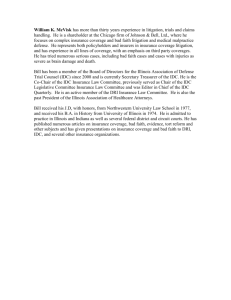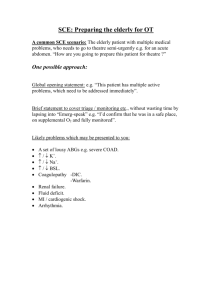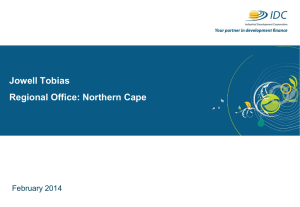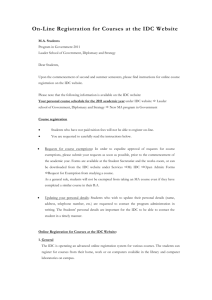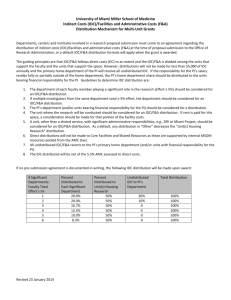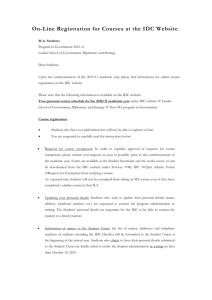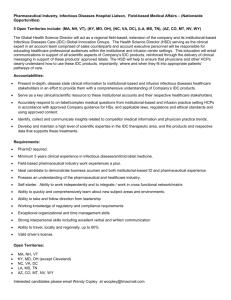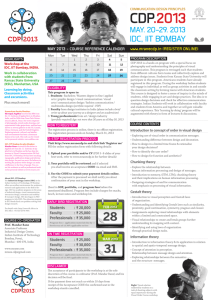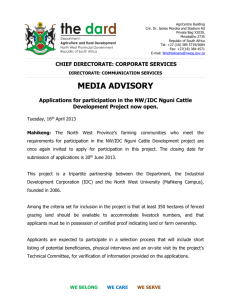IDC MarketScape: Worldwide Datacenter Infrastructure Management 2015 Vendor Assessment IDC MarketScape
advertisement
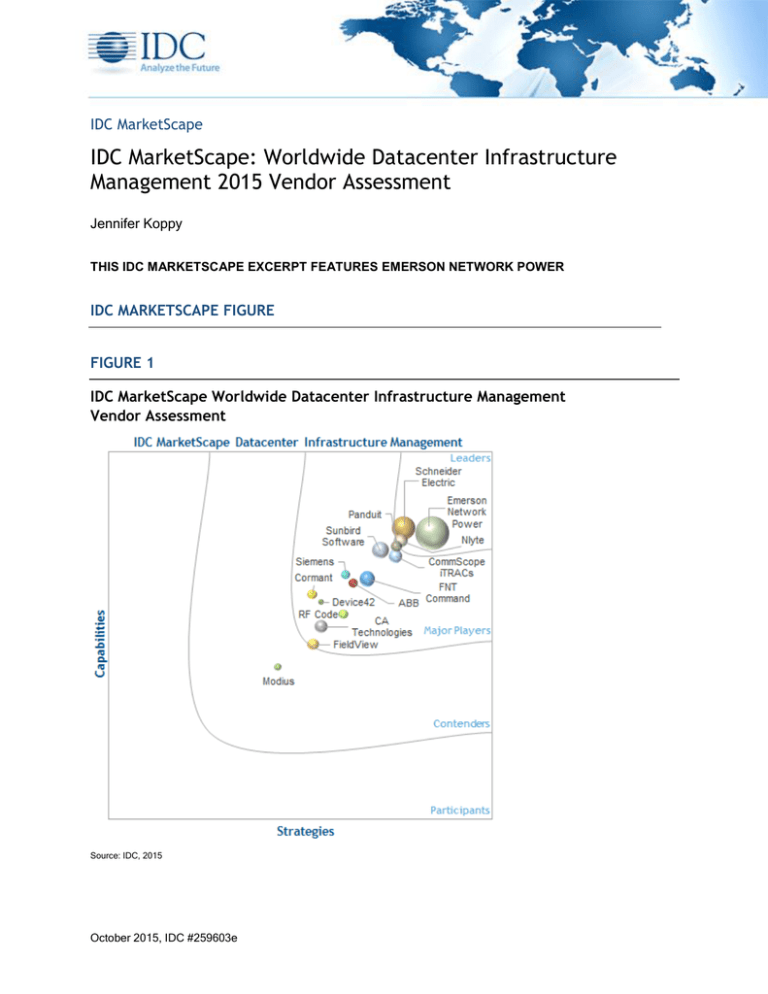
IDC MarketScape IDC MarketScape: Worldwide Datacenter Infrastructure Management 2015 Vendor Assessment Jennifer Koppy THIS IDC MARKETSCAPE EXCERPT FEATURES EMERSON NETWORK POWER IDC MARKETSCAPE FIGURE FIGURE 1 IDC MarketScape Worldwide Datacenter Infrastructure Management Vendor Assessment Source: IDC, 2015 October 2015, IDC #259603e Please see the Appendix for detailed methodology, market definition, and scoring criteria. IN THIS EXCERPT The content for this excerpt was taken directly from IDC MarketScape: Worldwide Datacenter Infrastructure Management 2015 Vendor Assessment (Doc #259603). All or parts of the following sections are included in this excerpt: IDC Opinion, IDC MarketScape Vendor Inclusion Criteria, Essential Guidance, Vendor Summary Profile, Appendix and Learn More. Also included is Figure 1. IDC OPINION The ultimate goal of a datacenter is to deliver IT service to end customers, and datacenter managers are under increasing pressure to deliver this service quickly, wherever and whenever needed, without compromising uptime and reliability. Datacenter infrastructure management (DCIM), when implemented well and supported across the enterprise, can be a critical step in delivering datacenter resources "as a service" to customers. Key steps in DCIM implementation are gaining support within the organization, selecting the best DCIM solution for the particular situation, and ensuring that the implementation of and ongoing commitment to the solution creates a positive outcome and shows a strong return on investment (ROI). Selecting the most appropriate DCIM solution should start with an assessment of the future strategy for delivering IT service to customers. With many enterprise IT organizations moving toward a distributed datacenter strategy, where the datacenter is a collection of resources (owned or colocated) in the different regions in which the company does business, it will be important to select a solution that can be localized to the region and also a services organization that can deploy and maintain the solution in all geographies. As many service providers seek to manage lights-out datacenters, the ability to remotely monitor and control resources becomes even more critical. The ability for a DCIM provider to enable secure connections and automate tasks becomes a competitive differentiator. When evaluating vendors, the key criteria companies should consider include: Ability to integrate and interact with the many other management tools in the datacenter. From disparate and legacy BMSs to cloud-based ITSM solutions, the ability for the DCIM solution to either feed data into another management solution or serve as the aggregator for disparate sources of data will enhance the usefulness to the entire organization. Scalability of the solution to encompass very large sets of data from many datacenter types (on-premise, edge, and colocated). As the datacenter evolves to become a distributed array of datacenter resources, the ability of the solution to reach across physical borders and aggregate real-time data in a secure way will be a competitive differentiator. Investment in predictive analytics and automation technologies to enable the lights-out datacenter. Monitoring capability is table stakes in DCIM, but running an agile and efficient datacenter requires the ability to analyze large amounts of data to drive proactive decisions on management and maintenance of resources. IDC MARKETSCAPE VENDOR INCLUSION CRITERIA This research includes analysis of 15 DCIM providers that sell solutions that enable visibility into components on the facilities side of the business (such as power distribution units [PDUs], ©2015 IDC #259603e 2 uninterruptable power supplies [UPSs], sensors, generators) and components on the IT side of the business (such as servers, storage, networking equipment). Some offer control over the resources; others are monitoring tools. Beyond the basic product functionality, the providers were required to have solutions available for purchase for at least one year (since April 2014) and must earn at least $2 million in revenue from the product in 2014. ESSENTIAL BUYER GUIDANCE Datacenter infrastructure management represents a collection of tools designed to increase the visibility and control over datacenter resources. Based on users' perspective, the term DCIM can mean different things. To IT professionals, the asset management and workflow functionality of DCIM is often what is most relevant to their role. To facilities managers, the power and environmental monitoring and provisioning functions may be what they consider as an important functionality in a DCIM solution. In IDC's view, the coordination of these functions is central to a truly software-defined datacenter architecture. Developing IT agility and improving the delivery of service requires a comprehensive view and management of resources that incorporates all physical infrastructure from the ground up — including the critical facilities to the IT equipment contained within it mapped to the workloads they support. Each DCIM provider in this IDC MarketScape approaches the market a little differently, making a direct comparison of these collection of tools a difficult task. Some solutions are very comprehensive and resemble enterprise resource management (ERP) tools; others focus solely on physical location of assets and their connectivity with a basic power monitoring capability. Still others approach DCIM as a next-generation building management system (BMS). Figure 2 shows IDC's depiction of functions required to run a smart-IT-enabled datacenter, which is a facility that uses advanced automation and integration solutions to measure, monitor, control, and optimize facility and IT operations to speed the delivery of, increase the efficiency of, and increase the agility of IT service delivery. DCIM solutions cover much of this functionality, but not all providers cover all of the areas. In the Vendor Summary Profiles section, a figure is used for each vendor to generalize the vendor's area of focus in delivering a smart-IT-enabled datacenter. In selecting the appropriate solution, IDC recommends considering some of the market forces that elevate the importance and escalate the need for better management of datacenter resources. In addition to comparing products based on the key problem they can solve, the capability of the services organization should also be a consideration. An honest assessment of the organization's ability to dedicate the human capital and time to implement the solution on its own is critical to success. ©2015 IDC #259603e 3 FIGURE 2 Functionality of a Smart-IT-Enabled Datacenter Note: IDC defines a smart-IT-enabled datacenter as a facility that uses advanced automation and integration solutions to measure, monitor, control, and optimize facility and IT operations to speed the delivery of, increase the efficiency of, and increase the agility of IT service delivery. Source: IDC, 2015 VENDOR SUMMARY PROFILES This section briefly explains IDC's key observations resulting in a vendor's position in the IDC MarketScape. While every vendor is evaluated against each of the criteria outlined in the Appendix, the description here provides a summary of each vendor's offering. Emerson Network Power Emerson Network Power has a long history in the DCIM market and a large installed base of end users that are using Trellis and Aperture (from the Avocent acquisition in 2009 and Aperture in 2008). Emerson Network Power's purchase of Liebert in 1987 provided additional power and cooling monitoring functionality to the company portfolio. The Trellis platform represents the company's vision for consolidating these various capabilities for optimizing datacenter resources and connecting IT services with the physical facilities organization. Over the past two years, the company has been working on transitioning its installed base to the Trellis platform. This transition was a major platform shift in DCIM, with Trellis a complete re-architecture from the ground up. Through this process, Emerson has grown from its roots as a critical facilities equipment provider, learned the nuances required of a successful software and services provider, and emerged as one of the foremost DCIM ©2015 IDC #259603e 4 solutions on the market today, with customers spanning from midsize internal/enterprise datacenters to large service provider datacenters. Through the transition, Emerson has built a portfolio of best practices with early adopter customers that it can leverage with customers that are new to the Trellis platform. Emerson is positioned as a Leader in the worldwide datacenter infrastructure management 2015 IDC MarketScape. The Trellis platform was built as an integrated suite of capabilities to support datacenters that strive for increased agility and automation of resources. Emerson's customers rely on the solution to support decisions on capacity planning, capital expenditures, audit compliance, problem identification and trouble ticketing, and optimizing the physical environment including power, thermal, space, and assets. For some users, setting up a comprehensive view of all datacenter resources that integrates with BMS and ITSM solution is daunting. A solution such as Trellis provides the most value when it is used across the organization by IT, facilities, and business units and integrates well with other management solutions. Recognizing that not all potential customers can make the commitment to such an expansive management initiative, the company is also offering specific bundles addressing specific operations within the datacenter. These bundles represent a low-risk entry point with quick ROI for the customer to DCIM. IDC believes these bundles will allow organizations to grow at a pace appropriate for them and take a gradual approach to better management practices. Figure 8 shows IDC's view of Trellis' functionality aligned with solutions that deliver a smart-IT-enabled datacenter. IDC defines a smart-IT-enabled datacenter as a facility that uses advanced automation and integration solutions to measure, monitor, control, and optimize facility and IT operations to speed the delivery of, increase the efficiency of, and increase the agility of IT service delivery. Trellis' strengths are across the full spectrum of critical facilities, monitoring and automation, and IT management functions. While many DCIM vendors stay clear of the access and control of the critical facilities equipment, Emerson addresses this segment via Liebert environmental controls and automation. On the IT side, Emerson partners with ITSM providers to enable control up through the physical and virtual IT environments. ©2015 IDC #259603e 5 FIGURE 8 Emerson Network Power Trellis Functionality to Support the Smart-IT-Enabled Datacenter Source: IDC, 2015 IDC expects Emerson to continue with its strong investments in the Trellis platform to increase the automation of datacenter management and more closely align IT service demands with the critical facilities resources, covering a range of operating models. One of the strengths of the Trellis platform is the global service organization. With the increasingly global nature of business creating demand for resources in multiple geographies, the ability to manage from a central data repository while meeting the unique needs of the regional datacenters is a differentiator. Improving ease of use continues to be a goal for most enterprise-class DCIM solutions, and Emerson Network Power has made investments to unify the end-user experience with Trellis with a common look and feel and streamlined processes with the solution. Strengths Trellis is a comprehensive solution to support all aspects of datacenter management, from the critical facilities management and control side up through to the IT management layer. Emerson's global services organization has matured with the market and is a key selling point for companies with datacenter resources around the world. Challenges As an expansive solution, Trellis is inherently complicated. Further improvements in ease of use and visualization to enhance and simplify the user experience will drive further adoption. ©2015 IDC #259603e 6 APPENDIX Reading an IDC MarketScape Graph For the purposes of this analysis, IDC divided potential key measures for success into two primary categories: capabilities and strategies. Positioning on the y-axis reflects the vendor's current capabilities and menu of services and how well aligned the vendor is to customer needs. The capabilities category focuses on the capabilities of the company and product today, here and now. Under this category, IDC analysts will look at how well a vendor is building/delivering capabilities that enable it to execute its chosen strategy in the market. Positioning on the x-axis, or strategies axis, indicates how well the vendor's future strategy aligns with what customers will require in three to five years. The strategies category focuses on high-level decisions and underlying assumptions about offerings, customer segments, and business and go-tomarket plans for the next three to five years. The size of the individual vendor markers in the IDC MarketScape represents the market share of each individual vendor within the specific market segment being assessed. IDC MarketScape Methodology IDC MarketScape criteria selection, weightings, and vendor scores represent well-researched IDC judgment about the market and specific vendors. IDC analysts tailor the range of standard characteristics by which vendors are measured through structured discussions, surveys, and interviews with market leaders, participants, and end users. Market weightings are based on user interviews, buyer surveys, and the input of a review board of IDC experts in each market. IDC analysts base individual vendor scores, and ultimately vendor positions on the IDC MarketScape, on detailed surveys and interviews with the vendors, publicly available information, and end-user experiences in an effort to provide an accurate and consistent assessment of each vendor's characteristics, behavior, and capability. Market Definition IDC defines DCIM as solutions that manage, optimize, and aid in planning for resources in datacenters, including IT hardware, power, cooling, and physical space. DCIM solutions, as defined by IDC, see components on the IT side (such as servers, storage systems, network switches, routers, and virtual machines) and components on the facilities side (such as cooling unit, power distribution unit [PDU], uninterruptable power supply [UPS], sensors, and generators). Access to these resources requires input and coordination between the facilities organization and the IT organization to create a holistic view of the datacenter. According to IDC's definition, DCIM does not include proprietary software designed to monitor a single product. LEARN MORE Related Research Market Analysis Perspective: Worldwide Datacenter Trends, 2015 (IDC #258853, September 2015) Worldwide Datacenter Infrastructure Management Solutions Forecast, 2015-2019 (IDC #256542, June 2015) IDC PeerScape: Practices for Better Datacenter Infrastructure Management (IDC #256625, June 2015) ©2015 IDC #259603e 7 Impact of Internet of Things on Datacenter Demand and Operations (IDC #255397, April 2015) IDC MaturityScape: Datacenter Infrastructure Management Solutions (IDC #251705, October 2014) Synopsis This IDC study uses the IDC MarketScape model to provide an assessment of 15 vendors participating in the datacenter infrastructure management (DCIM) market. The IDC MarketScape is an evaluation based on a comprehensive framework and a set of parameters that assesses providers relative to one another and to those factors expected to be most conducive to success in a given market during both the short term and the long term. "DCIM is a collection of tools to increase the visibility into and control over datacenter resources from the critical facilities layer up through to the IT management layer. The providers in this space approach these management challenges in different ways. As organizations investigate a software-defined approach to IT architecture, the inclusion of solutions such as DCIM that enable visibility through the critical facilities layer should be considered. This research uncovers the breadth and scope of the providers' offerings and their strategies for enabling datacenter resources to be viewed as pools of resources to enable greater agility and flexibility." — Jennifer Koppy, research director, Datacenter Trends and Strategies ©2015 IDC #259603e 8 About IDC International Data Corporation (IDC) is the premier global provider of market intelligence, advisory services, and events for the information technology, telecommunications and consumer technology markets. IDC helps IT professionals, business executives, and the investment community make factbased decisions on technology purchases and business strategy. More than 1,100 IDC analysts provide global, regional, and local expertise on technology and industry opportunities and trends in over 110 countries worldwide. For 50 years, IDC has provided strategic insights to help our clients achieve their key business objectives. IDC is a subsidiary of IDG, the world's leading technology media, research, and events company. Global Headquarters 5 Speen Street Framingham, MA 01701 USA 508.872.8200 Twitter: @IDC idc-insights-community.com www.idc.com Copyright Notice This IDC research document was published as part of an IDC continuous intelligence service, providing written research, analyst interactions, telebriefings, and conferences. Visit www.idc.com to learn more about IDC subscription and consulting services. To view a list of IDC offices worldwide, visit www.idc.com/offices. Please contact the IDC Hotline at 800.343.4952, ext. 7988 (or +1.508.988.7988) or sales@idc.com for information on applying the price of this document toward the purchase of an IDC service or for information on additional copies or Web rights. [trademark] Copyright 2015 IDC. Reproduction is forbidden unless authorized. All rights reserved.
